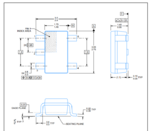neazoi
Advanced Member level 6
I have built this simple comparator which produces a pattern like a magic eye on a spinning motor which internally has a reset transistor. This is a pov screen
The comparator operated from about 0.5v to 2.5v when feeding DC at its input.
The problem is that:
1. below 0.5v input signal the pattern is switched completely off. So I need something to hold it to that level permanently.
2. I tried a diode voltage doubler at the input, but even if I turned the volume of my sound blaster to maximum, the "deflection" was small. How to cope with this in conjunction with the problem 1??
My intention is to use it as an RF detector so I am posting this on this thread.
The comparator operated from about 0.5v to 2.5v when feeding DC at its input.
The problem is that:
1. below 0.5v input signal the pattern is switched completely off. So I need something to hold it to that level permanently.
2. I tried a diode voltage doubler at the input, but even if I turned the volume of my sound blaster to maximum, the "deflection" was small. How to cope with this in conjunction with the problem 1??
My intention is to use it as an RF detector so I am posting this on this thread.

